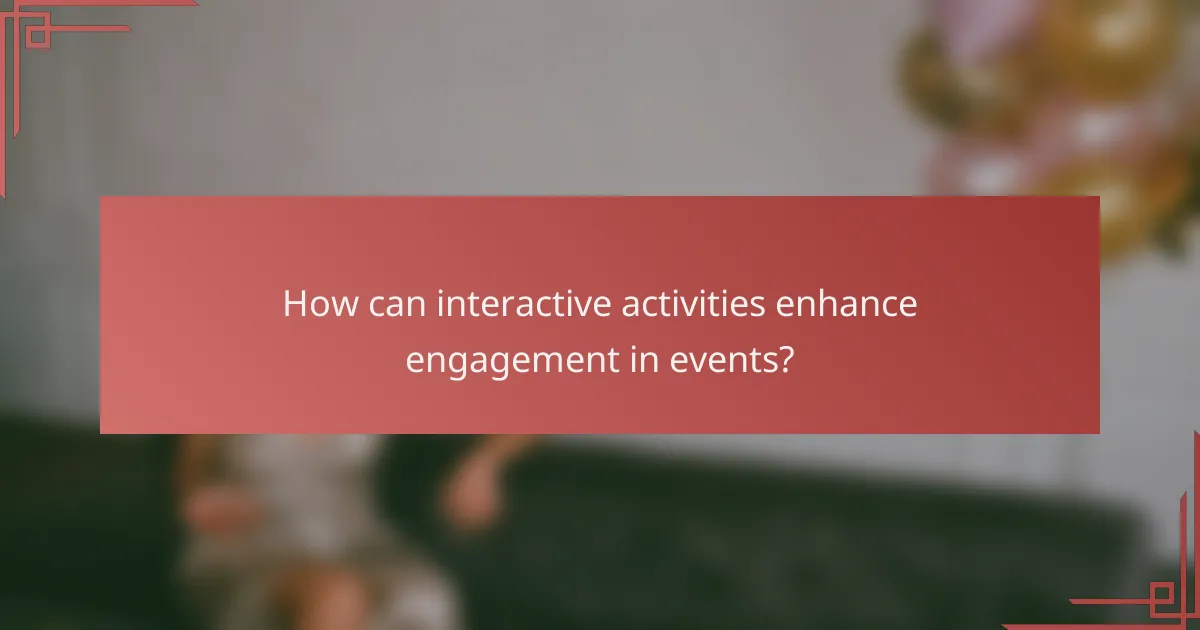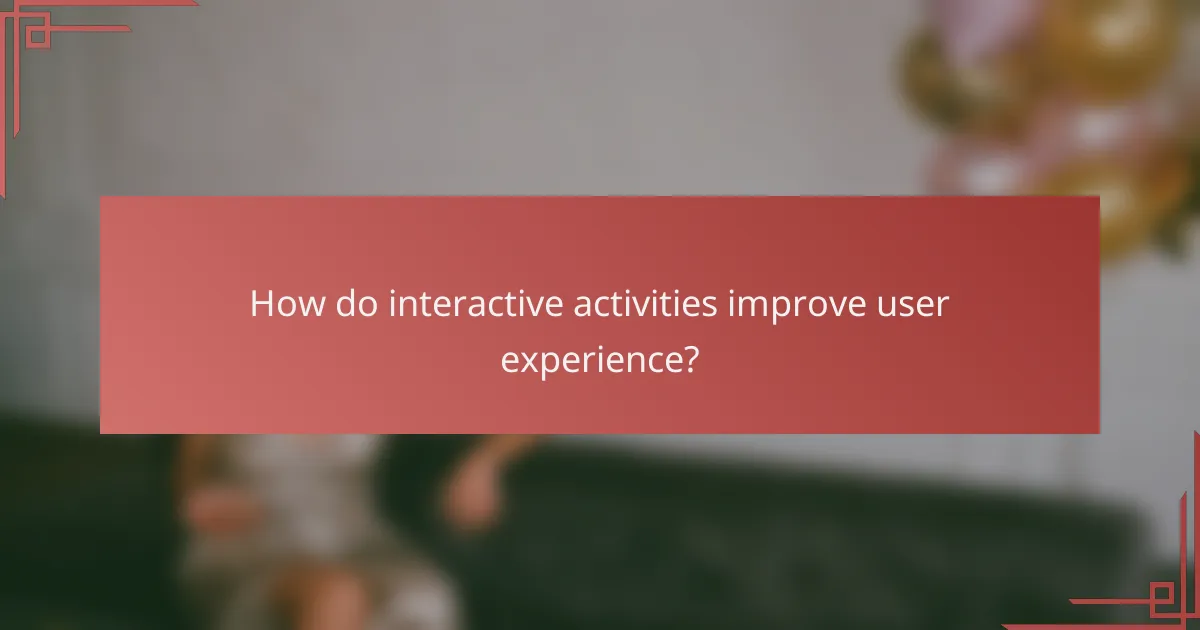Interactive activities play a crucial role in enhancing engagement and participation during events, creating a more immersive and memorable experience for participants. By fostering a sense of community and connection, these activities encourage individuals to actively contribute rather than simply observe, ultimately leading to greater satisfaction and retention.

How can interactive activities enhance engagement in events?
Interactive activities significantly boost engagement in events by actively involving participants, making them feel more connected and invested. These activities foster a sense of community and encourage participation, leading to a more memorable experience.
Gamification techniques
Gamification techniques incorporate game-like elements into events to motivate and engage participants. This can include point systems, leaderboards, and rewards for participation, which create a competitive yet fun atmosphere.
For example, using a mobile app where attendees earn points for attending sessions or networking can enhance interaction. Consider implementing small prizes for top participants to further incentivize engagement.
Live polling and Q&A sessions
Live polling and Q&A sessions allow attendees to voice their opinions and ask questions in real-time, fostering a more dynamic dialogue. Tools like Slido or Mentimeter can facilitate instant feedback and interaction.
Encourage participation by integrating polls into presentations, allowing attendees to influence topics discussed. This not only enhances engagement but also ensures that the content remains relevant to the audience’s interests.
Interactive workshops
Interactive workshops provide hands-on experiences that encourage collaboration and skill development among participants. These sessions can include group activities, brainstorming sessions, or problem-solving tasks that require active involvement.
To maximize effectiveness, keep groups small and focused, allowing for deeper discussions and personalized feedback. Consider scheduling multiple workshops on different topics to cater to diverse interests within the audience.
Augmented reality experiences
Augmented reality (AR) experiences blend digital content with the real world, creating immersive environments that captivate attendees. This technology can be used for interactive displays, virtual tours, or gamified experiences that enhance the event’s theme.
For instance, using AR apps to showcase product features or historical information can engage participants in a unique way. Ensure that the technology is user-friendly to avoid frustrating attendees who may be unfamiliar with AR.
Social media integration
Integrating social media into events encourages attendees to share their experiences and connect with others. Creating event-specific hashtags and encouraging posts can amplify engagement and reach beyond the physical space.
Consider setting up screens displaying live social media feeds, showcasing attendee posts and interactions. This not only promotes community but also provides real-time feedback on the event’s atmosphere and content.

What are the best practices for participation in interactive activities?
Effective participation in interactive activities hinges on clear communication, motivating incentives, and robust feedback systems. These elements enhance engagement and ensure that participants feel valued and involved throughout the experience.
Clear instructions and objectives
Providing clear instructions and well-defined objectives is crucial for successful participation in interactive activities. Participants should understand what is expected of them, the goals of the activity, and how to achieve those goals. This clarity minimizes confusion and encourages active involvement.
Consider using step-by-step guides or visual aids to illustrate the process. For example, if conducting a workshop, outline the agenda and expected outcomes at the beginning. This sets a clear framework for participants to follow.
Incentives for participation
Incentives play a significant role in motivating individuals to engage in interactive activities. These can range from tangible rewards, such as gift cards or discounts, to intangible benefits like recognition or skill development. Tailoring incentives to the audience can significantly boost participation rates.
For instance, in educational settings, offering certificates or badges for completing activities can encourage learners to participate more actively. In corporate environments, linking participation to performance reviews or team-building rewards can enhance engagement.
Feedback mechanisms
Implementing effective feedback mechanisms is essential for improving interactive activities and fostering participant engagement. Regular feedback allows participants to understand their performance and areas for improvement, creating a loop of continuous enhancement.
Consider using surveys or quick polls to gather participant insights after each activity. This not only shows that their opinions are valued but also provides actionable data to refine future activities. Aim to keep feedback processes simple and accessible to encourage honest responses.

How do interactive activities improve user experience?
Interactive activities enhance user experience by fostering engagement and participation, leading to a more immersive environment. They encourage users to actively participate rather than passively consume content, resulting in increased satisfaction and retention.
Personalization of content
Personalization allows users to tailor their experience based on preferences and behavior. By analyzing user data, platforms can offer customized content that resonates with individual interests, making the interaction more relevant and enjoyable.
For example, streaming services often recommend shows based on viewing history, which keeps users engaged. Implementing user surveys or feedback mechanisms can further refine personalization efforts.
Real-time interaction
Real-time interaction enables immediate feedback and communication, enhancing the overall experience. Users can ask questions, share opinions, or participate in discussions as events unfold, creating a dynamic environment.
Consider live webinars or interactive polls during presentations; these formats allow participants to engage actively, leading to higher retention of information and a sense of community involvement.
Community building
Community building fosters connections among users, enhancing their overall experience. When individuals feel part of a community, they are more likely to engage consistently and share their experiences with others.
Platforms can facilitate community building through forums, social media groups, or collaborative projects. Encouraging user-generated content, such as reviews or testimonials, can also strengthen community ties and enhance the interactive experience.

What tools can facilitate interactive activities?
Several tools can enhance interactive activities by promoting engagement, participation, and experience enhancement. These platforms provide features that facilitate real-time interaction, collaboration, and feedback, making them essential for effective communication in various settings.
Slido for audience engagement
Slido is a powerful tool designed to boost audience engagement during presentations and events. It allows participants to ask questions, vote on topics, and respond to polls in real time, creating a dynamic interaction between speakers and attendees.
To effectively use Slido, set up polls or Q&A sessions ahead of time and encourage participants to join via a simple link or code. This can significantly increase participation and make the audience feel more involved.
Common pitfalls include not promoting the tool beforehand or failing to moderate questions, which can lead to confusion. Ensure to allocate time for Q&A to maximize engagement.
Miro for collaborative brainstorming
Miro is an online collaborative whiteboard platform that facilitates brainstorming sessions and creative collaboration. Users can create mind maps, flowcharts, and other visual aids in real time, making it ideal for teams working remotely or in hybrid environments.
To get the most out of Miro, invite team members to contribute ideas simultaneously and use templates to streamline the process. This encourages diverse input and can lead to innovative solutions.
Be cautious of overwhelming participants with too many features at once. Start with basic tools and gradually introduce more complex functionalities as users become comfortable with the platform.
Mentimeter for live feedback
Mentimeter is an interactive presentation tool that allows users to gather live feedback from their audience through polls, quizzes, and word clouds. This immediate feedback can help presenters adjust their content on the fly based on audience reactions.
To utilize Mentimeter effectively, create engaging questions that encourage participation and share the presentation link with your audience. This can enhance the overall experience and provide valuable insights into audience preferences.
One tip is to keep questions concise and relevant to maintain engagement. Avoid asking too many questions in one session, as this can lead to participant fatigue and lower response rates.

What are the criteria for selecting interactive activities?
Selecting interactive activities involves assessing their ability to engage participants, enhance experiences, and foster meaningful participation. Key criteria include the activity’s relevance to the audience, the level of interactivity it offers, and the resources required for effective implementation.
Relevance to Audience
The relevance of an interactive activity to the audience is crucial for engagement. Consider the demographics, interests, and preferences of the participants. Activities that resonate with the audience’s experiences or aspirations are more likely to capture their attention and encourage active participation.
For instance, a tech-savvy audience may prefer activities that involve digital tools, while a more traditional group might engage better with hands-on, physical activities. Tailoring the content to the audience’s needs enhances the overall experience.
Level of Interactivity
The level of interactivity is a significant factor in selecting activities. High interactivity often leads to greater engagement and retention of information. Activities can range from simple Q&A sessions to complex simulations or collaborative projects.
For example, using live polls or interactive quizzes can keep participants engaged during presentations. Consider incorporating elements that allow for real-time feedback and participation to maximize the interactive experience.
Resources Required
Assessing the resources required for an interactive activity is essential for successful implementation. This includes time, budget, and materials needed. Activities that require extensive resources may not be feasible for all organizations or events.
When planning, create a checklist of necessary resources and compare different activities based on their cost-effectiveness and required effort. Simple activities, such as group discussions or brainstorming sessions, often require fewer resources while still providing valuable engagement opportunities.



